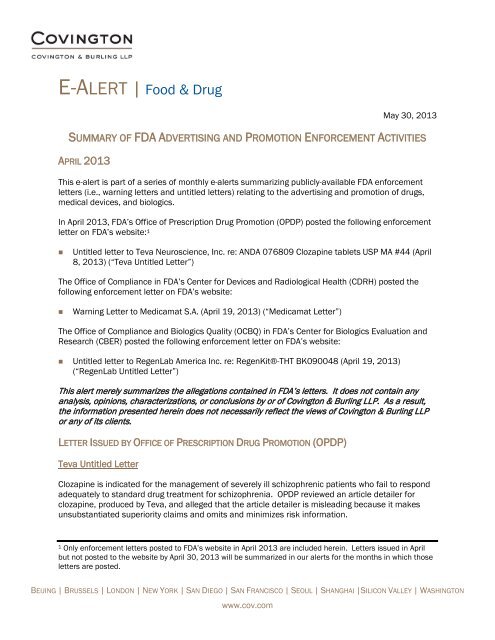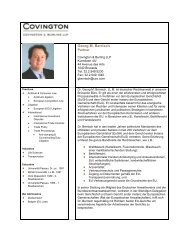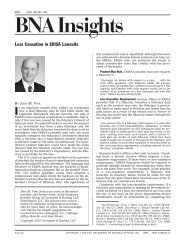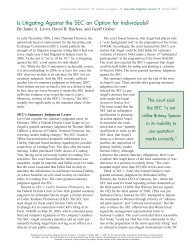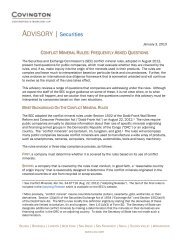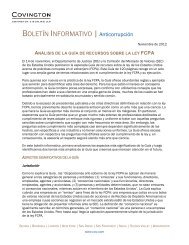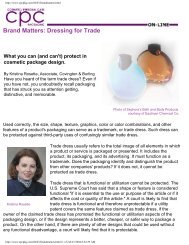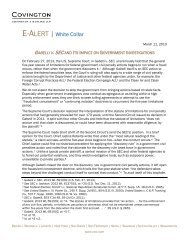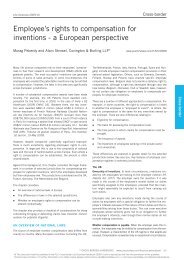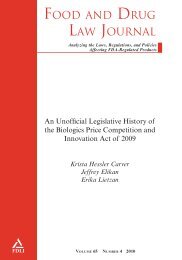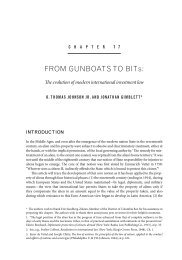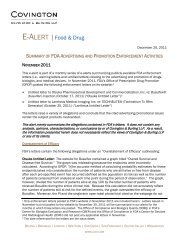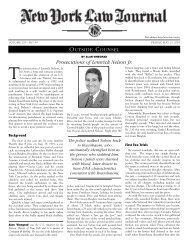Summary of FDA Advertising and Promotion Enforcement Activities
Summary of FDA Advertising and Promotion Enforcement Activities
Summary of FDA Advertising and Promotion Enforcement Activities
Create successful ePaper yourself
Turn your PDF publications into a flip-book with our unique Google optimized e-Paper software.
E-ALERT | Food & Drug<br />
May 30, 2013<br />
SUMMARY OF <strong>FDA</strong> ADVERTISING AND PROMOTION ENFORCEMENT ACTIVITIES<br />
APRIL 2013<br />
This e-alert is part <strong>of</strong> a series <strong>of</strong> monthly e-alerts summarizing publicly-available <strong>FDA</strong> enforcement<br />
letters (i.e., warning letters <strong>and</strong> untitled letters) relating to the advertising <strong>and</strong> promotion <strong>of</strong> drugs,<br />
medical devices, <strong>and</strong> biologics.<br />
In April 2013, <strong>FDA</strong>’s Office <strong>of</strong> Prescription Drug <strong>Promotion</strong> (OPDP) posted the following enforcement<br />
letter on <strong>FDA</strong>’s website: 1<br />
• Untitled letter to Teva Neuroscience, Inc. re: ANDA 076809 Clozapine tablets USP MA #44 (April<br />
8, 2013) (“Teva Untitled Letter”)<br />
The Office <strong>of</strong> Compliance in <strong>FDA</strong>’s Center for Devices <strong>and</strong> Radiological Health (CDRH) posted the<br />
following enforcement letter on <strong>FDA</strong>’s website:<br />
• Warning Letter to Medicamat S.A. (April 19, 2013) (“Medicamat Letter”)<br />
The Office <strong>of</strong> Compliance <strong>and</strong> Biologics Quality (OCBQ) in <strong>FDA</strong>’s Center for Biologics Evaluation <strong>and</strong><br />
Research (CBER) posted the following enforcement letter on <strong>FDA</strong>’s website:<br />
• Untitled letter to RegenLab America Inc. re: RegenKit®-THT BK090048 (April 19, 2013)<br />
(“RegenLab Untitled Letter”)<br />
This alert merely summarizes the allegations contained in <strong>FDA</strong>’s letters. It does not contain any<br />
analysis, opinions, characterizations, or conclusions by or <strong>of</strong> Covington & Burling LLP. As a result,<br />
the information presented herein does not necessarily reflect the views <strong>of</strong> Covington & Burling LLP<br />
or any <strong>of</strong> its clients.<br />
LETTER ISSUED BY OFFICE OF PRESCRIPTION DRUG PROMOTION (OPDP)<br />
Teva Untitled Letter<br />
Clozapine is indicated for the management <strong>of</strong> severely ill schizophrenic patients who fail to respond<br />
adequately to st<strong>and</strong>ard drug treatment for schizophrenia. OPDP reviewed an article detailer for<br />
clozapine, produced by Teva, <strong>and</strong> alleged that the article detailer is misleading because it makes<br />
unsubstantiated superiority claims <strong>and</strong> omits <strong>and</strong> minimizes risk information.<br />
1 Only enforcement letters posted to <strong>FDA</strong>’s website in April 2013 are included herein. Letters issued in April<br />
but not posted to the website by April 30, 2013 will be summarized in our alerts for the months in which those<br />
letters are posted.<br />
BEIJING | BRUSSELS | LONDON | NEW YORK | SAN DIEGO | SAN FRANCISCO | SEOUL | SHANGHAI |SILICON VALLEY | WASHINGTON<br />
www.cov.com
COVINGTON & BURLING LLP<br />
Unsubstantiated Claims / Unsubstantiated Superiority Claim: The article detailer included, among<br />
other things, the following statements about the effectiveness <strong>of</strong> three different drugs (including<br />
cozapine) on five symptom “clusters” associated with schizophrenia:<br />
• “Treatment with the three atypical agents studied (clozapine, olanzapine, <strong>and</strong> risperidone) was<br />
associated with significant improvements in 3 <strong>of</strong> 5 PANSS symptom clusters (positive, cognitive,<br />
depression/anxiety). Clozapine <strong>and</strong> olanzapine showed improvement in the negative cluster.<br />
Only clozapine was associated with significant improvement in the excitement symptom<br />
cluster.” 2<br />
• “Both clozapine <strong>and</strong> olanzapine improved the negative symptom cluster in a similar manner.” 3<br />
• “Clozapine, olanzapine, <strong>and</strong> risperidone all significantly improved the positive, cognitive, <strong>and</strong><br />
depression/anxiety symptom clusters.” 4<br />
• “The excitement domain findings <strong>of</strong> this study ‘further point to clozapine’s efficacy for patients<br />
having difficulty with aggression <strong>and</strong> impulse control.’” 5<br />
OPDP alleged that these claims are misleading because they “imply that clozapine demonstrated<br />
significant efficacy in treating four <strong>of</strong> the five ‘symptom clusters’ associated with schizophrenia …<br />
when this has not been demonstrated by substantial evidence or substantial clinical experience.”<br />
<strong>FDA</strong> noted that the claims were based on a retrospective, Positive <strong>and</strong> Negative Syndrome Scale<br />
(“PANSS”) derived five-factor analysis <strong>of</strong> data from a previously published prospective, r<strong>and</strong>omized,<br />
14-week clinical trial. <strong>FDA</strong> stated that this type <strong>of</strong> retrospective analysis does not constitute<br />
substantial evidence or substantial clinical experience <strong>and</strong> thus cannot be used to support the<br />
claims.<br />
Furthermore, OPDP stated that the claims “Clozapine was superior to both risperidone <strong>and</strong><br />
haloperidol in treating the excitement cluster” <strong>and</strong> “[o]nly clozapine was associated with<br />
improvement in the excitement domain,” 6 in conjunction with the comparative graphic presentation<br />
detailing the results <strong>of</strong> the PANSS-derived five factor analysis, misleadingly suggest that clozapine is<br />
superior to the other drugs studied in the excitement symptom cluster. OPDP noted that a single<br />
retrospective analysis is not considered substantial evidence or substantial clinical experience to<br />
support the “implication” <strong>of</strong> superiority for clozapine. Instead, OPDP stated that a head-to-head<br />
study is required.<br />
Omission <strong>and</strong> Minimization <strong>of</strong> Risk Information: OPDP also stated that the article detailer failed to<br />
disclose (1) that clozapine is contraindicated in patients with hypersensitivity to clozapine or any<br />
other component <strong>of</strong> the drug; <strong>and</strong> (2) numerous risks associated with clozapine such as QT interval<br />
prolongation, fever, <strong>and</strong> hepatitis (among others). OPDP noted that while the article detailer<br />
included limited information regarding QT interval prolongation, it failed to mention that clozapine<br />
treatment should be discontinued if the QTc interval exceeds 500 milliseconds, as stated in the<br />
approved label.<br />
OPDP also alleged that the article detailer misleadingly presented numerous efficacy claims by using<br />
colorful pictures, graphics, <strong>and</strong> large bolded headers surrounded by white space, while providing risk<br />
information in smaller print <strong>and</strong> in block paragraph format on the back page. Although, OPDP noted<br />
that the article detailer included the bolded statement “Please see back cover for additional<br />
2 Emphasis in article detailer.<br />
3 Emphasis in article detailer.<br />
4 Emphasis in article detailer.<br />
5 Emphasis in article detailer.<br />
6 Emphasis in article detailer.<br />
C&B<br />
2
COVINGTON & BURLING LLP<br />
indications, Important Safety Information, <strong>and</strong> enclosed Prescribing Information, including Boxed<br />
Warnings” on the bottom <strong>of</strong> page three (out <strong>of</strong> four). In OPDP’s view, however, this did not mitigate<br />
the misleading risk presentation.<br />
LETTER ISSUED BY CDRH OFFICE OF COMPLIANCE (OC)<br />
Medicamat Warning Letter<br />
Medicamat’s “Punch-Hair-Matic-S.A.F.E.R.” device is registered <strong>and</strong> listed as a Class I device, under<br />
an exemption for manual surgical instruments for general use (21 C.F.R. 8278.4800). According to<br />
CDRH’s warning letter to Medicamat, Medicamat’s “Punch-Hair-Matic-S.A.F.E.R.” device is<br />
misbr<strong>and</strong>ed because it is improperly registered as an exempt Class I device. CDRH stated that<br />
devices classified under this provision are intended to automate hair transplant for the surgical<br />
treatment <strong>of</strong> baldness, but Medicamat’s device is indicated to treat the first stages <strong>of</strong> male <strong>and</strong><br />
female diffuse hair loss <strong>and</strong> for thickening <strong>of</strong> the glabrous skin <strong>and</strong> eyebrow repair. According to<br />
CDRH, Medicamat’s device thus exceeds the limitations <strong>of</strong> 21 C.F.R. 878.9(a) because it has a<br />
different intended use than devices classified under 21 C.F.R. 878.4800, <strong>and</strong> is thus not exempt<br />
from premarket notification.<br />
LETTER ISSUED BY CBER OFFICE OF COMPLIANCE AND BIOLOGICS QUALITY (OCBQ)<br />
RegenLab Untitled Letter<br />
The RegenKit-THT was cleared for marketing under premarket notification (510(k)) submission,<br />
which included the following Indications for Use statement:<br />
The RegenKit®-THT is designed to be used for the safe <strong>and</strong> rapid<br />
preparation <strong>of</strong> autologous plateletrich plasma (PRP) from a small<br />
sample <strong>of</strong> blood at the patient’s point <strong>of</strong> care. The PRP is mixed with<br />
autograft <strong>and</strong>/or allograft bone prior to application to an orthopaedic<br />
surgical site as deemed necessary by the clinical use requirements.<br />
OCBQ alleged that RegenLab’s website, a tri-fold patient brochure, <strong>and</strong> a pr<strong>of</strong>essional brochure<br />
provide evidence that RegenLab is marketing its RegenKit-THT for cosmetic uses. OCBQ noted that<br />
the marketing materials contain “before” <strong>and</strong> “after” pictures <strong>of</strong> patients whose skin supposedly<br />
benefited from the use <strong>of</strong> RegenKit-THT. In addition, OCBQ cited the following statements:<br />
• “Deemed in the media as the “Vampire Lift”, people everywhere are learning that their own stem<br />
cell growth factors are the underlying drivers <strong>of</strong> having sustainable healthy skin. CALL NOW to<br />
ask your Eclipse Representative how unleashing the simple, quick, <strong>and</strong> advantageous RegenLab<br />
process into your practice will strengthen your aesthetic treatment outcomes <strong>and</strong> your pr<strong>of</strong>it<br />
margin!”<br />
• “Order a RegenLab Starter Pack <strong>and</strong> receive a FREE centrifuge <strong>and</strong> marketing kit!...[a]verage<br />
duration <strong>of</strong> a full-face treatment is 30-40 minutes.”<br />
• “With a simple, quick[,] <strong>and</strong> advantageous RegenLab process, your own blood is safely<br />
prepared on the physician’s premises <strong>and</strong> is delivered to your skin within the same treatment<br />
session.”<br />
• “RegenPlasma is regenerative medicine <strong>and</strong> works best aesthetically when it is introduced into<br />
the skin.”<br />
C&B<br />
3
COVINGTON & BURLING LLP<br />
• “[A]ccording to studies, the main goal <strong>of</strong> a RegenPlasma treatment is to stimulate fiberblast<br />
[sic] <strong>and</strong> develop long-term collagen formations in the dermis.”<br />
• “Most patients enjoy quantifiable improvements in skin complexion, texture[,] <strong>and</strong> tone usually<br />
within three weeks.”<br />
OCBQ’s letter alleged that these claims for cosmetic uses establish a new intended use for the<br />
device. Because the company lacks a clearance or approval for such intended uses, OCBQ alleged<br />
that these claims misbr<strong>and</strong>ed <strong>and</strong> adulterated the device.<br />
* * *<br />
If you have any questions concerning the material discussed in this client alert, please contact the<br />
following members <strong>of</strong> our Food & Drug Practice Group:<br />
Michael Labson +1.202.662.5220 mlabson@cov.com<br />
Erika Lietzan +1.202.662.5165 elietzan@cov.com<br />
Scott Cunningham +1.202.662.5275 scunningham@cov.com<br />
Scott Danzis +1.202.662.5209 sdanzis@cov.com<br />
Saurabh An<strong>and</strong> +1.202.662.5222 san<strong>and</strong>@cov.com<br />
This information is not intended as legal advice. Readers should seek specific legal advice before acting with regard to the subjects<br />
mentioned herein.<br />
Covington & Burling LLP, an international law firm, provides corporate, litigation <strong>and</strong> regulatory expertise to enable clients to achieve their<br />
goals. This communication is intended to bring relevant developments to our clients <strong>and</strong> other interested colleagues. Please send an<br />
email to unsubscribe@cov.com if you do not wish to receive future emails or electronic alerts.<br />
© 2013 Covington & Burling LLP, 1201 Pennsylvania Avenue, NW, Washington, DC 20004-2401. All rights reserved.<br />
C&B<br />
4


